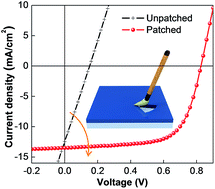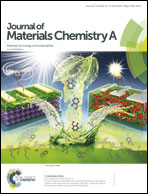Patching defects in the active layer of large-area organic solar cells†
Abstract
Large area fabrication of organic solar cells is critical to achieve sufficient energy for power applications. However, large-area organic solar cells still suffer from low production yields because their thin active layer (100–300 nm) is prone to form leakage current when film defects exist in the active layer. In this study, we proposed a novel strategy to patch the defects to suppress the leakage current and improve the device yield of large-area organic solar cells. The defects in the active layers have been patched by coating an insulating polymer using a Maobi tool that has the advantage of patterning and ink holding. Insulating polymers including polyethylenimine (PEI), polyvinyl alcohol (PVA), and polymethylmethacrylate (PMMA) have been used to patch the defects. Electrical insulativity, solution processability, solvent orthogonality to the active layer, good wetting on the active layer, and chemical inactivity with the active layer and interfacial layer are important properties for a good candidate used for patching the defects. The patching strategy is applicable to both fullerene-based and non-fullerene-based solar cells and can effectively restore the photovoltaic properties of the active layers with defects. Finally, we have demonstrated the construction of large-area (up to 52 cm2) monolithic none-fullerene organic solar cells with the assistance of the proposed patching strategy.



 Please wait while we load your content...
Please wait while we load your content...